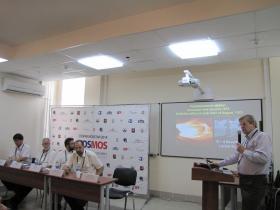"Currently all the instruments of the "RELEC" scientific complex are switched on in testing mode. Our objective is to make sure that they are operated correctly. <...> The first transients are "catched". We see that the instruments are operated in a proper way," - SINP Director and the Head of the "RELEC" project, Professor Mikhail Panasyuk told us during the press-conference on July 8, organized within the frames of COSPAR Assembly.
Mikhail Panasyuk also said, that soon the information obtained from "RELEC" will be compared with data from the RUssian spacecraft "Chibis-M" and American satellites "Van Allen". Their objectives are the same - the studies of the radiation processes in the near-Earth space and the Earth's atmosphere.
Scientific instrument "RELEC" (Relativistic ELECtrons) is a complex of scientific equipment developed by SINP scientists in collaboration with Russina (Space Research Institute RAS and Scientific and Research Laboratory of the Aerospace Engineering DOSAAF) and foreign (Lviv branch of Space Research Institute of the National Academy of Sciences and National Space Agency of Ukraine; Etvesh University, Hungary; Space Research Center of Polish Academy of Sciences; Songungvan University, Korea) partners. Scientific complex "RELEC" is mounted onboard the small spacecraft "MKA-FKI (PN2)", developed and produced by Lavochkin Scientific and Production Association. The spacecraft was launched on July 8, 2014.

